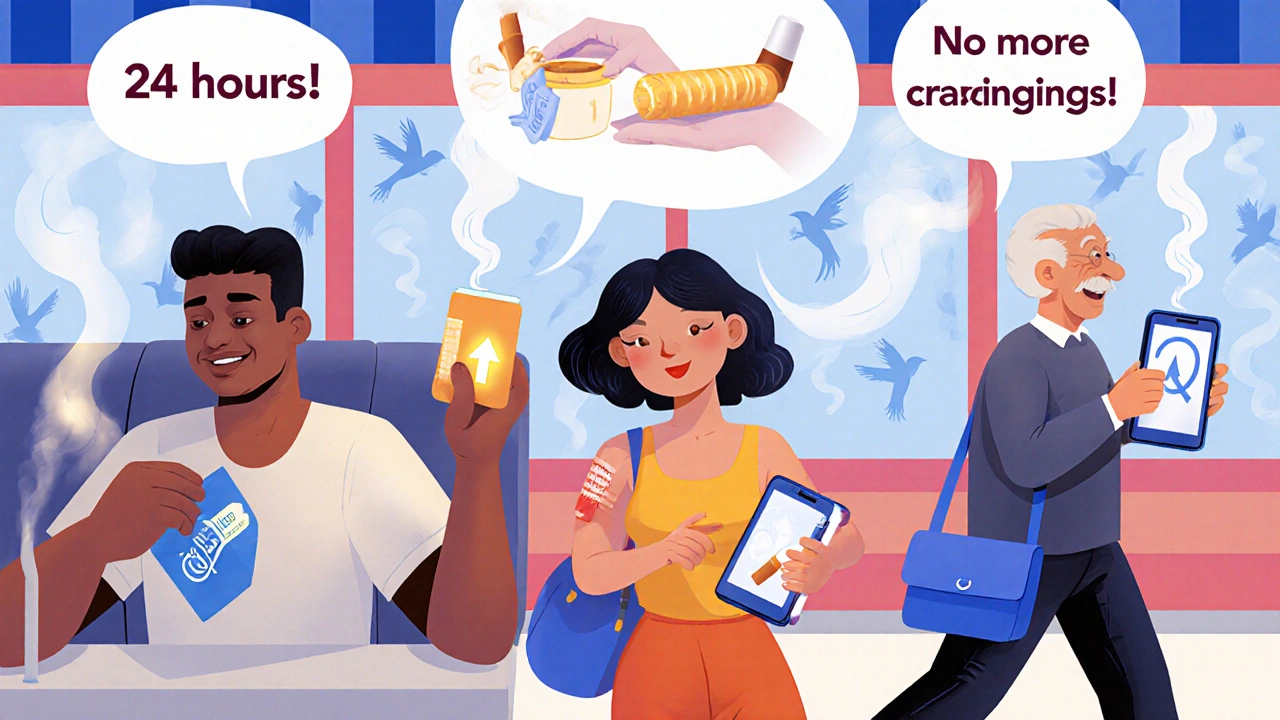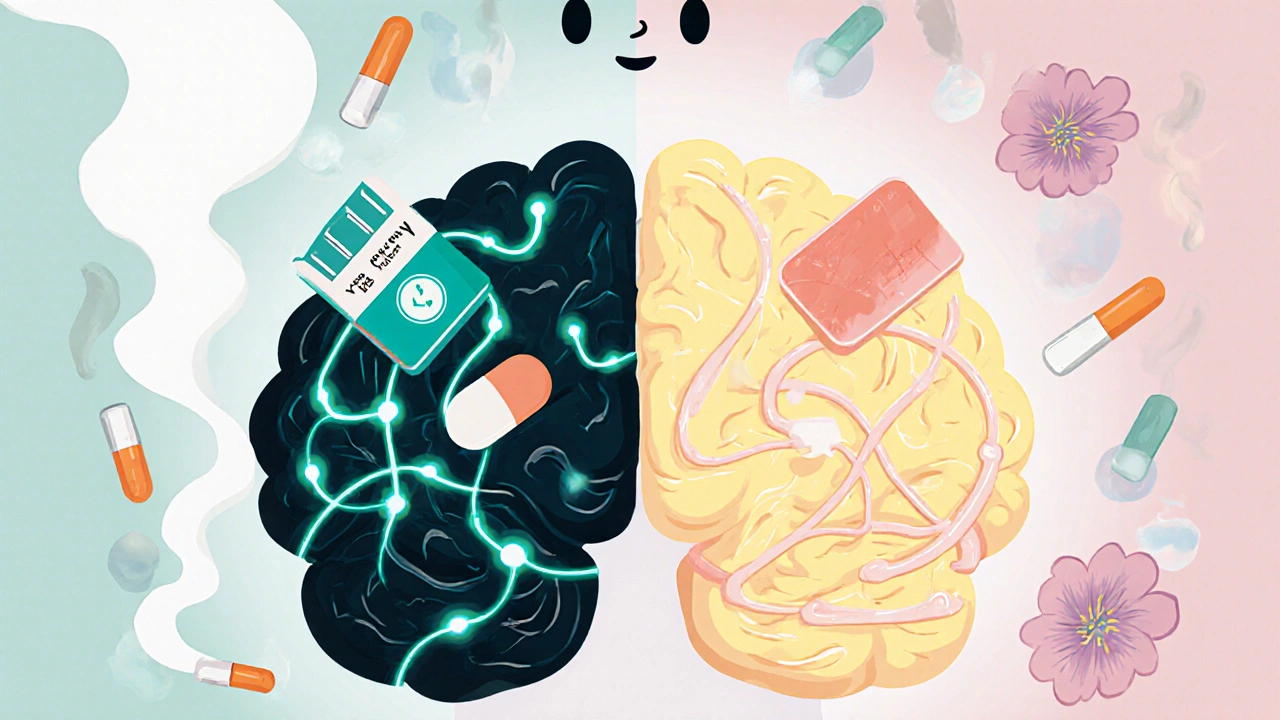Quitting smoking isn’t just about willpower. It’s about biology. Every cigarette you smoke floods your brain with nicotine, rewiring your reward system until your body begs for it. When you try to quit cold turkey, your brain goes into withdrawal - headaches, irritability, cravings so strong they feel like a physical pull. That’s why most people fail. But here’s the truth: smoking cessation works - if you use the right tools.
What Actually Works: The Science Behind Quitting
There are three FDA-approved medications that change the game: varenicline (Chantix), bupropion (Zyban), and nicotine replacement therapy (NRT). They don’t just help you cope - they rewire how your brain responds to nicotine.Varenicline is the most effective single medication you can take. Developed by Pfizer and approved in 2006, it works by partially activating nicotine receptors in your brain. This reduces cravings and blocks nicotine from giving you a high if you slip up. In the landmark EAGLES study, 21.8% of people using varenicline were still smoke-free after six months - nearly double the placebo rate. A 2022 meta-analysis of over 360 trials found varenicline was 32% more effective than NRT and 46% more effective than bupropion.
Bupropion, originally an antidepressant, helps by increasing dopamine and norepinephrine levels. It doesn’t contain nicotine, so it’s a good option if you want to avoid any form of replacement. Around 16% of users stay quit after six months. It’s also cheaper - a 30-day supply costs about $15 at Walmart’s generic program.
NRT comes in many forms: patches, gum, lozenges, nasal spray, and inhalers. The patch delivers steady nicotine to ease withdrawal. Gum and lozenges give you quick relief when a craving hits. Studies show NRT boosts quit rates to 9-16%, depending on how you use it. The key? Combine a long-acting form (like a patch) with a fast-acting one (like gum) for the best results.
Cost, Access, and Real-World Barriers
Money matters. Varenicline costs around $500 for a 12-week course without insurance. That’s a lot for someone on a tight budget. But bupropion? At $15 for a month’s supply, it’s affordable. NRT patches run about $45 for a week’s supply at Walgreens.Insurance coverage changes everything. In the U.S., 68% of people with private insurance get full coverage for cessation meds. But if you’re on Medicaid in a state that didn’t expand coverage, only 29% of you have access. That’s not just unfair - it’s deadly. Low-income smokers are more likely to die from smoking-related diseases, and cost is the #1 reason they don’t try medication.
Even when you can afford it, adherence is low. Only 44% of people finish the full 12-week course of varenicline. Why? Side effects. Nausea affects about 30% of users. Vivid dreams? That’s common too - 42% of Reddit users reported them. Some quit because of it. But here’s the twist: most side effects fade after the first two weeks. If you stick it out, the cravings get easier.
Combination Therapy: The Secret Weapon
The best results don’t come from one drug alone. They come from stacking them.A 2022 analysis found that combining varenicline with NRT nearly doubled your chances of quitting. The odds ratio jumped to 5.75 compared to placebo. That means for every 100 people who use both, 57 more stay quit than if they used nothing.
Here’s how to do it right: Start varenicline one to two weeks before your quit date. Take the patch daily to stabilize nicotine levels. Use gum or lozenges only when a craving hits - not as a constant crutch. Don’t double up on nicotine sources unless you’re under medical supervision. Too much can cause dizziness or rapid heartbeat.
Even if you can’t get varenicline, combining two NRTs - like a patch plus gum - works better than either alone. The CDC says this combo can increase success by 25% compared to using just one.

Behavioral Support: The Missing Piece
Medication helps your body. Counseling helps your mind.Studies show that even a 3-minute chat with your doctor increases your quit rate by 30%. That’s not a typo. Talking about your triggers - stress, coffee, social settings - makes you more prepared. Four or more counseling sessions? That’s the sweet spot. People who combine meds with counseling are twice as likely to quit long-term.
You don’t need a therapist. Free resources exist. The CDC’s quitline (1-800-QUIT-NOW) offers free coaching. Apps like QuitGuide and This is Quitting (by Truth Initiative) send daily tips based on your progress. In Australia, Quitline offers free phone and text support - no cost, no judgment.
One real-world example: A 48-year-old man in Melbourne quit after 25 years. He used varenicline, started with a 21mg patch, and chewed gum when he felt the urge. He called Quitline twice a week. He didn’t just stop smoking - he started walking every morning. That habit replaced the ritual. He’s been smoke-free for 14 months.
Side Effects and Safety: What No One Tells You
There’s been fear around varenicline. Early reports linked it to depression and suicidal thoughts. But the EAGLES study - the largest ever on this topic - found no increased risk of neuropsychiatric events compared to placebo, even in people with a history of depression or anxiety.That doesn’t mean it’s risk-free. Nausea is the most common side effect - about 30% of users feel it, especially in the first week. Take it with food. Drink water. It usually fades. Vivid dreams? Happens to about 1 in 3. If they’re disturbing, talk to your doctor - lowering the dose temporarily can help.
Bupropion can cause insomnia or dry mouth. NRT can cause jaw pain (gum) or throat irritation (spray). None of these are dangerous, but they can be annoying enough to make you quit the medication. Don’t let that happen. Most side effects are temporary. And they’re far less harmful than continuing to smoke.
One thing to watch: if you feel unusually anxious, depressed, or have thoughts of self-harm - stop the medication and call your doctor. It’s rare, but it happens. You’re not weak for needing help. You’re smart for recognizing it.
Who Benefits Most - And Who Should Avoid These Meds
Varenicline works better for some groups than others. Black smokers, for example, respond less to NRT and bupropion. But with varenicline, their quit rates jump to match those of white smokers. That’s huge. It’s one of the few smoking cessation tools that reduces racial disparities in outcomes.Older adults (45-64) use cessation meds more often than young adults. Why? They’ve seen the damage. They’ve lost friends. They’re ready.
People with severe mental illness - schizophrenia, bipolar disorder - can safely use varenicline. The American Thoracic Society specifically recommends it for them. In fact, quitting smoking improves psychiatric symptoms more than many medications do.
Who should avoid these? Pregnant women should avoid varenicline and bupropion unless absolutely necessary. NRT is safer in pregnancy - but only under medical supervision. People with seizure disorders should not take bupropion. And anyone with a history of allergic reaction to any of these drugs should skip them.

What’s Next: Cytisine and Personalized Quitting
There’s new hope on the horizon. Cytisine, a plant-based compound from Bulgaria, is similar to varenicline but costs a fraction of the price - about $10 for a full course. A 2024 meta-analysis showed it may be even more effective than varenicline, with fewer side effects. It’s not yet approved in the U.S., but it’s widely used in Europe and Australia.Future quitting may be personalized. Researchers are now testing how fast your body breaks down nicotine. If you’re a “fast metabolizer,” varenicline gives you a huge edge. If you’re a “slow metabolizer,” NRT might work just as well. Blood tests for nicotine metabolism are still experimental - but they’re coming.
The FDA approved a new 4mg nicotine lozenge in January 2023 for faster relief. That’s good news for people who used to smoke strong cigarettes or vape heavily. Quick relief means fewer slips.
Your Next Steps: How to Start Today
You don’t need to wait for the perfect day. Start now.- Decide on a quit date - within the next two weeks.
- Call your doctor or pharmacist. Ask about varenicline. If it’s too expensive, ask about bupropion or NRT.
- Enroll in free counseling - Quitline (1-800-QUIT-NOW) or your local health service.
- If you’re using NRT, get a 21mg patch and 4mg gum. Use the patch daily. Use the gum only when cravings hit.
- Start varenicline one to two weeks before your quit date. Take it with food to reduce nausea.
- Track your progress. Use an app. Tell one friend. Celebrate small wins - 24 hours, then 7 days, then 30.
Relapse isn’t failure. It’s data. If you smoke one cigarette, don’t quit the plan. Adjust it. Maybe you need more counseling. Maybe you need to switch from bupropion to varenicline. Maybe you need to avoid bars for a while. You’re not broken. You’re learning.
What’s the most effective medication to quit smoking?
Varenicline (Chantix) is the most effective single medication for quitting smoking, according to the American Thoracic Society and multiple clinical trials. It doubles your chances of quitting compared to placebo and is more effective than nicotine patches or bupropion. About 22% of users stay smoke-free after six months.
Can I use nicotine gum and a patch together?
Yes, combining a nicotine patch with gum or lozenges is not only safe - it’s recommended. The patch gives you steady nicotine to reduce withdrawal. The gum gives you fast relief when cravings strike. This combo increases your quit rate by 25% compared to using just one form of NRT.
Is varenicline safe if I have depression?
Yes. Early concerns about varenicline causing depression or suicidal thoughts were based on weak data. The large EAGLES study in 2016 found no increased risk in people with depression, anxiety, or other psychiatric conditions. In fact, quitting smoking often improves mood and reduces anxiety over time.
How long should I take smoking cessation medication?
For varenicline, the standard course is 12 weeks. If you’re doing well, your doctor may recommend continuing for another 12 weeks to reduce relapse risk. For NRT, most people taper off over 8-12 weeks. Don’t stop too soon - stopping early is the #1 reason people go back to smoking.
What if I can’t afford these medications?
Bupropion SR (generic Zyban) costs as little as $15 for a 30-day supply at Walmart. NRT patches and gum are available over-the-counter and sometimes covered by Medicaid. In Australia, Quitline offers free NRT samples to eligible residents. Check with your local health department - many programs provide free or low-cost cessation aids.
Do I need counseling to quit?
You don’t absolutely need it, but you’re twice as likely to succeed if you combine medication with counseling. Even five minutes of advice from your doctor increases your success rate by 30%. Free options include Quitline (1-800-QUIT-NOW), apps like This is Quitting, and online support groups.
What Happens After You Quit
Your body starts healing the day you stop. Within 20 minutes, your heart rate drops. After 12 hours, carbon monoxide leaves your blood. In 2 weeks, your circulation improves. By 9 months, lung function gets noticeably better. After a year, your risk of heart disease is cut in half.But the biggest win isn’t physical - it’s freedom. You’re no longer controlled by a craving. You don’t have to plan your day around smoke breaks. You don’t have to hide your habit. You breathe easier. You taste food again. You save money - thousands a year.
Quitting isn’t easy. But it’s the most powerful health decision you’ll ever make. And you don’t have to do it alone. The tools are here. The science is clear. Now it’s your turn to use them.



kshitij pandey
Man, I quit smoking last year using varenicline and a patch. First two weeks were rough-nausea and weird dreams, but after that? Total game changer. I didn’t even miss the ritual. Now I save over $300 a month and my cough is gone. You got this.